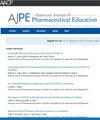Using Politeness Theory to Deconstruct How Preregistrant Pharmacists Approach Disagreement in the Workplace
IF 3.5
4区 教育学
Q1 EDUCATION, SCIENTIFIC DISCIPLINES
引用次数: 0
Abstract
Objective
Using politeness theory, this study investigates how preregistrant pharmacists engage in workplace disputes.
Methods
Overall, 56 students participated in 2 mock job judgment scenarios. In scenario A (n = 25), the conflict was with a colleague of lower hierarchical status, while in scenario B (n = 32), the conflict was with a colleague of equal hierarchical status. Using politeness theory, responses were coded into 3 tiers: (1) engagement in the face-threatening act (FTA); (2) use of on/off-record approaches; and (3) communicative strategies. For tier 1, reasons for engaging in the FTA were also coded.
Results
89% of the participants indicated they would unequivocally engage in the FTA. For scenario A, the pharmacist’s roles and responsibilities (40%) and for scenario B, situational urgency/safety (65%) were the key drivers. Scenario A participants were more likely to use an on-record approach (80%) than those in scenario B (68%). Empathetic approaches (56%) were more common in scenario A, while explanatory approaches (64%) were more frequent in scenario B.
Conclusion
This study shows that preregistrant pharmacists are aware of the principles of face-work. While the study only reflects what participants believe they would do, not their actual ability in professional disputes, it supports current research that students need simulated low-stakes opportunities to practice communication skills before entering the workplace, especially where situational urgency is present. Integration of politeness theory in workshop and feedback design could help students to link awareness to actual interaction, although the theory should be expanded to integrate urgency as a factor impacting all levels of interactional decision-making.
利用礼貌理论解构注册前药剂师如何处理工作场所中的分歧。
目的: 本研究采用礼貌理论,调查了注册前药剂师如何参与工作场所纠纷:本研究利用礼貌理论,调查了注册前药剂师如何参与工作场所纠纷:56 名学生参与了两个模拟工作判断情景。在情景 A(n = 25)中,冲突是与级别较低的同事发生的,而在情景 B(n = 32)中,冲突是与级别相同的同事发生的。利用礼貌理论,我们将回答分为三类:1)参与威胁他人的行为(FTA);2)使用记录在案/不记录在案的方法;3)交流策略。对于第 1 层,还对参与面部威胁行为的原因进行了编码:结果:89% 的参与者表示他们会明确采取 FTA。对于情景 A,药剂师的角色和责任(40%)以及情景 B,情况紧急/安全(65%)是主要驱动因素。与情景 B 的参与者(68%)相比,情景 A 的参与者更倾向于使用记录在案的方法(80%)。在情景 A 中,移情方法(56%)更为常见,而在情景 B 中,解释方法(64%)更为常见:本研究表明,注册前药剂师了解面对面工作的原则。虽然这项研究只反映了参与者认为他们会做的事情,而不是他们在职业纠纷中的实际能力,但它支持了当前的研究,即学生在进入职场前需要模拟低风险的机会来练习沟通技巧,尤其是在情境紧迫的情况下。在工作坊和反馈设计中融入礼貌理论,可以帮助学生将意识与实际互动联系起来,尽管该理论应扩展到将紧迫性作为影响各级互动决策的一个因素。
本文章由计算机程序翻译,如有差异,请以英文原文为准。
求助全文
约1分钟内获得全文
求助全文
来源期刊
CiteScore
4.30
自引率
15.20%
发文量
114
期刊介绍:
The Journal accepts unsolicited manuscripts that have not been published and are not under consideration for publication elsewhere. The Journal only considers material related to pharmaceutical education for publication. Authors must prepare manuscripts to conform to the Journal style (Author Instructions). All manuscripts are subject to peer review and approval by the editor prior to acceptance for publication. Reviewers are assigned by the editor with the advice of the editorial board as needed. Manuscripts are submitted and processed online (Submit a Manuscript) using Editorial Manager, an online manuscript tracking system that facilitates communication between the editorial office, editor, associate editors, reviewers, and authors.
After a manuscript is accepted, it is scheduled for publication in an upcoming issue of the Journal. All manuscripts are formatted and copyedited, and returned to the author for review and approval of the changes. Approximately 2 weeks prior to publication, the author receives an electronic proof of the article for final review and approval. Authors are not assessed page charges for publication.

 求助内容:
求助内容: 应助结果提醒方式:
应助结果提醒方式:


